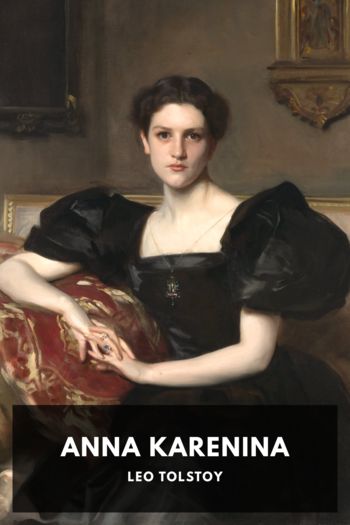What Is Art? Leo Tolstoy (good books to read for 12 year olds TXT) 📖

- Author: Leo Tolstoy
Book online «What Is Art? Leo Tolstoy (good books to read for 12 year olds TXT) 📖». Author Leo Tolstoy
From Boccaccio to Marcel Prévost, all the novels, poems, and verses invariably transmit the feeling of sexual love in its different forms. Adultery is not only the favourite, but almost the only theme of all the novels. A performance is not a performance unless, under some pretence, women appear with naked busts and limbs. Songs and romances—all are expressions of lust, idealised in various degrees.
A majority of the pictures by French artists represent female nakedness in various forms. In recent French literature there is hardly a page or a poem in which nakedness is not described, and in which, relevantly or irrelevantly, their favourite thought and word nu is not repeated a couple of times. There is a certain writer, René de Gourmond, who gets printed, and is considered talented. To get an idea of the new writers, I read his novel, Les Chevaux de Diomède. It is a consecutive and detailed account of the sexual connections some gentleman had with various women. Every page contains lust-kindling descriptions. It is the same in Pierre Louÿs’ book, Aphrodite, which met with success; it is the same in a book I lately chanced upon—Huysmans’ Certains, and, with but few exceptions, it is the same in all the French novels. They are all the productions of people suffering from erotic mania. And these people are evidently convinced that as their whole life, in consequence of their diseased condition, is concentrated on amplifying various sexual abominations, therefore the life of all the world is similarly concentrated. And these people, suffering from erotic mania, are imitated throughout the whole artistic world of Europe and America.
Thus in consequence of the lack of belief and the exceptional manner of life of the wealthy classes, the art of those classes became impoverished in its subject-matter, and has sunk to the transmission of the feelings of pride, discontent with life, and, above all, of sexual desire.
XIn consequence of their unbelief the art of the upper classes became poor in subject-matter. But besides that, becoming continually more and more exclusive, it became at the same time continually more and more involved, affected, and obscure.
When a universal artist (such as were some of the Grecian artists or the Jewish prophets) composed his work, he naturally strove to say what he had to say in such a manner that his production should be intelligible to all men. But when an artist composed for a small circle of people placed in exceptional conditions, or even for a single individual and his courtiers—for popes, cardinals, kings, dukes, queens, or for a king’s mistress—he naturally only aimed at influencing these people, who were well known to him, and lived in exceptional conditions familiar to him. And this was an easier task, and the artist was involuntarily drawn to express himself by allusions comprehensible only to the initiated, and obscure to everyone else. In the first place, more could be said in this way; and secondly, there is (for the initiated) even a certain charm in the cloudiness of such a manner of expression. This method, which showed itself both in euphemism and in mythological and historical allusions, came more and more into use, until it has, apparently, at last reached its utmost limits in the so-called art of the Decadents. It has come, finally, to this: that not only is haziness, mysteriousness, obscurity, and exclusiveness (shutting out the masses) elevated to the rank of a merit and a condition of poetic art, but even incorrectness, indefiniteness, and lack of eloquence are held in esteem.
Théophile Gautier, in his preface to the celebrated Fleurs du Mal, says that Baudelaire, as far as possible, banished from poetry eloquence, passion, and truth too strictly copied (“l’éloquence, la passion, et la vérité calquée trop exactement”).
And Baudelaire not only expressed this, but maintained his thesis in his verses, and yet more strikingly in the prose of his Petits Poèmes en Prose, the meanings of which have to be guessed like a rebus, and remain for the most part undiscovered.
The poet Verlaine (who followed next after Baudelaire, and was also esteemed great) even wrote an “Art poétique,” in which he advises this style of composition:—
De la musique avant toute chose,
Et pour cela préfère l’Impair
Plus vague et plus soluble dans l’air,
Sans rien en lui qui pèse ou qui pose.
Il faut aussi que tu n’ailles point
Choisir tes mots sans quelque méprise:
Rien de plus cher que la chanson grise
Où l’Indécis au Précis se joint.
⋮
And again:—
De la musique encore et toujours!
Que ton vers soit la chose envolée
Qu’on sent qui fuit d’une âme en allée
Vers d’autres cieux à d’autres amours.
Que ton vers soit la bonne aventure
Éparse au vent crispé du matin,
Qui va fleurant la menthe et le thym …
Et tout le reste est littérature.68
After these two comes Mallarmé, considered the most important of the young poets, and he plainly says that the charm of poetry lies in our having to guess its meaning—that in poetry there should always be a puzzle:—
Je pense qu’il faut qu’il n’y ait qu’allusion, says he. La contemplation des objets, l’image s’envolant des rêveries suscitées par eux, sont le chant: les Parnassiens, eux, prennent la chose entièrement et la montrent; par là ils manquent de mystère; ils retirent aux esprits cette joie délicieuse de croire qu’ils créent. Nommer un objet, c’est supprimer les trois quarts de la jouissance du poème, qui est faite du bonheur de deviner peu à peu: le suggérer, voilà le rêve. C’est le parfait usage de ce mystère qui constitue le symbole: évoquer petit à petit un objet pour





Comments (0)